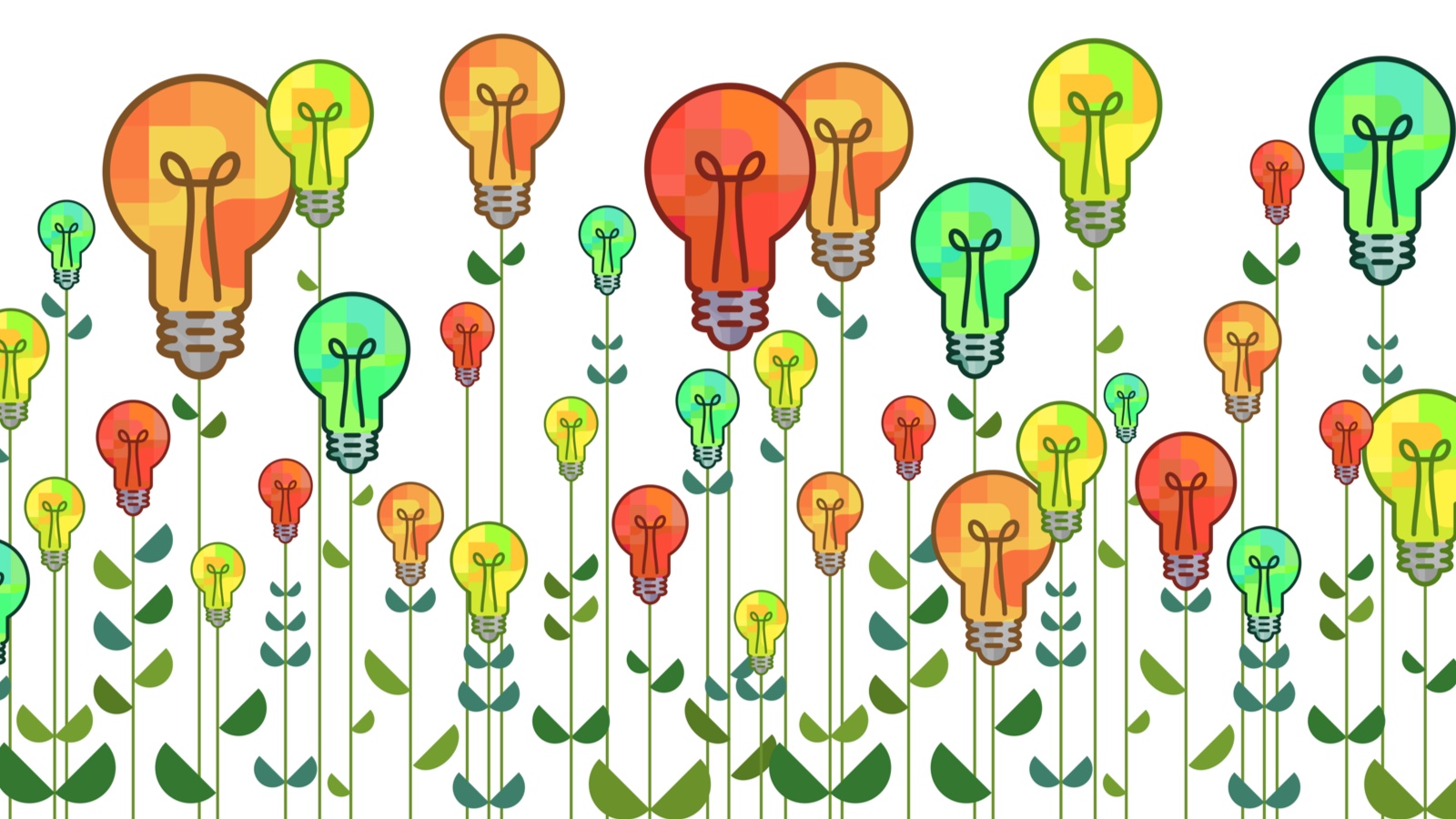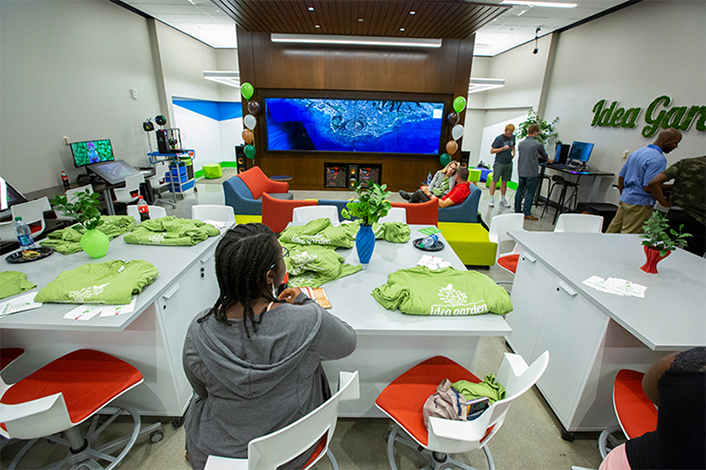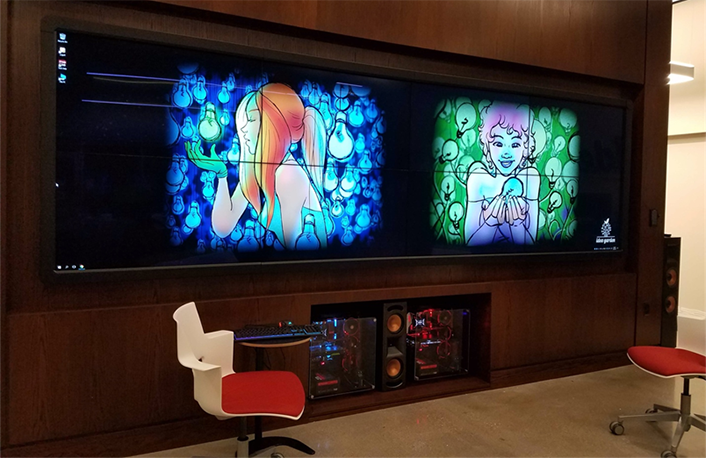How can immersive informal learning spaces evolve to support student collaboration during the coronavirus pandemic?

Informal learning spaces are becoming increasingly popular at higher education institutions. Many institutions are repurposing study halls, libraries, computer labs, and other spaces to address the educational goals of a broader set of students. These informal learning spaces often include new technologies and offer students a flexible multipurpose space for extending their learning outside of classes.Footnote1 They can be particularly powerful for providing students access to STEM technologies that would otherwise be unavailable to them.
Immersive informal learning spaces should be designed to support STEM students' creative thinking and collaboration. Incorporating virtual reality (VR) technology is a great way to offer interactive experiences to students.Footnote2 The Idea Garden at Indiana University–Purdue University Indianapolis (IUPUI) opened on October 3, 2018, and was designed to encourage STEM students to think creatively and to collaborate with their peers (see Figure 1). The physical space is equipped with 3D printers, high-performance PCs, VR headsets, Dell Canvas touchscreen workspaces, Microsoft Surface computers, and an IQ-Wall touchscreen video display. The Idea Garden functions not only as a learning space but also as a social space. And while many of us in the teaching and learning profession have focused on socially distanced classroom design in response to the coronavirus pandemic, we on the Indiana University Information Technology Services (UITS) Learning Technologies Unit research team have had an opportunity to examine how spaces like the Idea Garden can evolve to support student collaboration.

According to the United Nations Educational, Scientific, and Cultural Organization (UNESCO), by March 24, 2020, nearly 80 percent of the world's student population had been impacted by school closures and had switched suddenly to online learning.Footnote3 However replicating face-to-face learning experiences in online environments is a challenge. This is especially true for immersive informal learning spaces like the Idea Garden because these types of spaces provide students with "learning-by-doing" experiences. Knowledge and skills are obtained through active participation, group work, play, and other immersive interactions rather than through lectures.Footnote4 As higher education teaching and learning professionals move through the pandemic, ensuring that informal learning spaces continue to evolve to support student connections within and outside of the university is critical.
To best address STEM students' educational goals, understanding how students feel about the design of the space and the technology and services that are available in the space—as well as how they are actually using the space and its features—is critical. Prior to the pandemic, our research team conducted a study to examine students' perceptions related to using the Idea Garden. Our goal was to assist other universities who may be planning to design immersive informal learning spaces. We surveyed 458 students and interviewed nine students to examine their perceptions of the Idea Garden. The following research questions guided this project:
- How is the Idea Garden used as an immersive informal learning space?
- What are the STEM students' use and perceptions of the learning affordances of immersive informal learning spaces?
Survey Participants' Demographics
A majority of survey respondents were male (see Table 1). A substantial majority of students who participated in the study were freshman (39%), followed by sophomores (19%), juniors (15%), and seniors (13%) (see Table 2).Footnote5
Table 1. Gender of Survey Respondents
| Gender | Count | Percentage |
|---|---|---|
| Male | 303 | 66.1% |
| Female | 116 | 25.3% |
| Prefer not to respond | 13 | 4.1% |
| N/A | 19 | 2.8% |
| Other | 7 | 1.5% |
| Total | 458 | 100.0% |
Table 2. Class Standing of Survey Respondents
| Class Standing | Count | Percentage |
|---|---|---|
| Freshman | 181 | 39.5% |
| Sophomore | 89 | 19.4% |
| Junior | 70 | 15.2% |
| Senior | 62 | 13.5% |
| N/A | 21 | 4.5% |
| Graduate | 20 | 4.3% |
| Other | 15 | 3.2% |
| Total | 458 | 100.0% |
Interestingly, accounting majors (a non-STEM field) made up the largest group of visitors to the Idea Garden (N=64). All other visitors were STEM majors: media arts and science (N=45), mechanical engineering (N=34), and music technology (N=17) (see Figure 2), as well as biology, chemistry, human computer interaction, neuroscience, and biomedical engineering.

Findings
Students indicated that they came to the space for four primary reasons: they were curious (N=219); they wanted to try out new technologies (N=93); they wanted to hang out with friends (N=51); and they wanted to work on class projects (N=33).Footnote6
In addition, students liked using the following technologies the most:
- VR headsets (N=282)
- 3D printers (N=121)
- Interactive whiteboard (N=105)
- Microsoft Surface desktop computers (N=80)
When we asked respondents how many times they had visited the Idea Garden so far, 50% of the female students reported that they had visited once so far, and 28.3% of the male students said they had visited more than ten times (see Table 3). Just over 42% of seniors reported that they had visited the Idea Garden once so far, whereas 31.1% of freshman said they had visited more than ten times (see Table 4).
Table 3. Frequency of Visits by Gender
| Female | Male | Other | Prefer not to respond | N/A | Total | |
|---|---|---|---|---|---|---|
| More than ten times | 12.9% | 28.3% | 14.2% | -- | 17.6% | 22.9% |
| Six to ten times | 12.9% | 10.3% | 14.2% | 38.4% | 11.7% | 11.9% |
| This is my first time | 50.0% | 31.0% | 71.4% | 38.4% | 29.4% | 36.6% |
| Two to five times | 24.1% | 30.3% | -- | 23.0% | 41.1% | 28.4% |
| Total | 100.0% | 100.0% | 100.0% | 100.0% | 100.0% | 100.0% |
Table 4. Frequency of Visits by Class Standing
| Fresh- man |
Soph- omore |
Junior | Senior | Other | Grad | N/A | Total | |
|---|---|---|---|---|---|---|---|---|
| More than ten times | 31.1% | 29.2% | 5.8% | 14.7% | 6.6% | 25.0% | 15.7% | 22.9% |
| Six to ten times | 11.1% | 7.8% | 18.8% | 13.1% | 6.6% | 10.0% | 15.7% | 11.9% |
| This is my first time | 33.3% | 32.5% | 40.5% | 42.6% | 66.6% | 40.0% | 26.3% | 36.6% |
| Two to five times | 24.4% | 30.3% | 34.7% | 29.5% | 20.0% | 25.0% | 42.1% | 28.4% |
| Total | 100.0% | 100.0% | 100.0% | 100.0% | 100.0% | 100.0% | 100.0% | 100.0% |
In addition, two focus-group interviews were conducted to gather in-depth information regarding students' ideas and feelings about the Idea Garden space, as well as to understand the differences in perspectives with respect to the learning affordances of immersive informal learning spaces. Survey respondents who indicated that they had used the Idea Garden space and technologies previously were selected to participate. For qualitative analysis, the interview transcriptions were analyzed using NVivo software. We were interested in learning about four themes: motivation to visit the Idea Garden; favorite technologies used in the space; learning experiences through immersive tools; and suggestions for improving the Idea Garden.
What motivated you to visit the Idea Garden?
Students shared many of the same thoughts during the focus-group interviews as they had shared in their survey responses. For example, "Emma," an accounting major, said that she comes to the Idea Garden to hang out with friends, to work on assignments, and to release some stress by playing VR games.
I live on the campus [and] . . . this is a very good study place for me. So, I come here and study . . . . I just do whatever assignments that I have to complete. [T]his is a fun and interactive place to come . . . and finish my assignments. And if I need to get some stress relief, I just come here to play some video games. . . . It is also a great place for . . . friends to hangout.
"Jacob," a media arts and science major, said he comes to Idea Garden to work on projects. "A lot of times, I would use the screens/touch screens [IQ wall] to work on assignments," he explained. "Or, I would just work on my laptop in the space. To de-stress, I definitely use the VR system."
"Sophia," also a media arts and science major, mentioned that her professors teach some classes in the Idea Garden. "This semester, a lot of my professors in the IT building were really interested in the space," she said. "They actually taught their class in the area. They started having physical classes in this space."
What are your favorite technologies in this space?
VR headsets and a large, ultra-high resolution, tiled video display system called the "IQ Wall," ranked as the most frequently used technologies in the room (see Figure 3). IQ Walls were developed by the UITS Advanced Visualization Lab to promote collaborative visual technology at IUPUI. The IQ Wall allows multiple users to connect and interact collaboratively. Students can also use the IQ Wall to run challenging visualization or graphics-intensive applications such as games, video-editing software, and graphic-design software.

Google Maps, Adobe Illustrator, and 3D-modelling software are among the most used applications in the Idea Garden. Emma said that she enjoys using Google Maps on the IQ Wall and uses most of the technology for entertainment purposes.
Jacob, on the other hand, uses the technologies in the Idea Garden to complete schoolwork. "I . . . use different computers and their touch screens," he said. "Mainly, I . . . work on projects using Illustrator.
Like Jacob, Sophia uses the computers to work on her school projects.
They are just more intuitive than my personal tablet. . . . I like the things that are really easy and really fun. There are a lot of educational tools, like 3D-model spaces, that you can [use to] learn things about places in the world that you cannot physically go to.
In addition, Sophia said that she enjoys helping the staff who are working in the Idea Garden space. "I do like to show off the IQ Wall." She said she would even like to help run the IQ Wall someday.
What do you think about learning through immersive technologies?
All undergraduate students at IUPUI are required to take six credit hours of core communication classes. When students were asked for their opinions about how immersive technologies, such as VR headsets, influence their learning and interest in engineering design, art, graphic design, or computer science, Emma stated that the immersive tools provide her with opportunities to practice certain skills, like public speaking, in a safe environment. "There is a program [in the Idea Garden] that allows us to practice public speaking. So that really benefits us as students."
Sophia emphasized the efficiency and effectiveness of using VR tools to simulate tasks that are difficult to do in real life, such as completing a 3D examination of a human body, or to decrease the cost of activities like sculpturing and painting (see Figure 4).
VR right now is the cutting edge of the gaming of industry. It is not just applicable for gaming, either. It [can] also [be] applied in the arts and sciences. I think it is really interesting because you can do things in VR . . . like [create] 3D models and stuff that . . . you cannot do it in real life. You can learn how things are made [and] experience [things] on a . . . more in-depth scale . . . like with anatomy. And you can simulate things before you actually go through them. It is practicing tool. And it is a good learning tool in general.
One of my favorite things [about VR] is that it does not require [you to purchase] the materials that you would usually need to make . . . a physical thing in the real world. It is not nearly as expensive . . . . I like using 3D models to make sculptures and to paint on the canvas. . . . If we adopt these [programs], it can cut down significantly of the price of the clays. And you can still make details in different models.

Discussion and Conclusion
In this paper, we examined students' experiences in a space at IUPUI called the Idea Garden and illustrated that VR systems and informal space design can be used as teaching tools in STEM disciplines such as engineering design, art, design, and computer science, as well as non-STEM fields such as accounting.
Data from the student surveys and focus-group interviews indicated that VR headsets were among the most-used technology in this space. A systematic literature review conducted in 2018 showed that most of the research on immersive technologies has focused on fostering students' conceptual understanding and affective learning outcomes in STEM fields.Footnote7 Similarly, we observed that students used VR tools in the Idea Garden to enhance their conceptual knowledge in certain subjects (examining enlarged 3D models of smaller objects like blood vessels or cell structures to gain a more in-depth understanding of their biology, for example), as well as to improve their presentation and public-speaking skills. The cost efficiency of VR is another important aspect that influenced learning. Especially in the art and design field, VR seemed to decrease the amount—and by extension the cost—of materials, such as clay, paint, and canvas, that students had to purchase. With millions of students now studying remotely due to the global health crisis, VR technology might be an efficient solution for art and design students who do not have a studio at home and who cannot afford to purchase these materials.
The informal context of the Idea Garden attracted students from diverse departments such as accounting and finance, music technology, engineering, and computer science. In their 2015 article, Cameron DeLeon Denson, Chandra Austin, Christine Hailey, and Daniel Householder argued that a productive informal learning context must (1) promote awareness, (2) provide academic enrichment, (3) be supported by the educational system, and (4) have competent instructors.Footnote8 Given that students visited the Idea Garden to satisfy their curiosity, to try out new technologies, and to work on class projects, the space can be considered an effective environment for students' academic and social interactions. The technical support and mentoring staff in the Idea Garden also contribute to the effectiveness of the room. However, students also expressed a desire to have clearer instructional materials covering how to use the technology in the room without the help of the staff, which suggests that the Idea Garden encourages students to become self-directed learners.
As social-distancing protocols were implemented at higher education institutions, collaborative knowledge-sharing activities have been challenged formally and informally. This study, which was conducted before the pandemic began, raises questions about how technology-enhanced informal learning spaces like the Idea Garden can evolve to support STEM students' collaboration and learning experiences.
Acknowledgments
The authors would like to thank the people who contributed to this article, particularly Meina Zhu and Chris Andrews.
Notes
- Cyprian Lomas and Diana G. Oblinger, "Student Practices and Their Impact on Learning Spaces," in Learning Spaces, Diana G. Oblinger, ed. (Washington DC: EDUCAUSE, 2006), 5.1–5.11.2 Jump back to footnote 1 in the text.
- Maria Roussou, "Immersive Interactive Virtual Reality and Informal Education," in Proceedings of User Interfaces for All: Interactive Learning Environments for Children, ed. Constantine Stephanidis, (Athens, Greece: i3 Spring Days, 2000). Jump back to footnote 2 in the text.
- UNESCO, "1.37 Billion Students Now Home as COVID-19 School Closures Expand, Ministers Scale Up Multimedia Approaches to Ensure Learning Continuity," news release March 24, 2020. Jump back to footnote 3 in the text.
- Monique Boekaerts and Alexander Minnaert, "Self-Regulation with Respect to Informal Learning," International Journal of Educational Research 3 no. 6, (August 1999): 533–544. Jump back to footnote 4 in the text.
- Ibid. Jump back to footnote 5 in the text.
- Ibid. Jump back to footnote 6 in the text.
- María-Blanca Ibáñez and Carlos Delgado-Kloos, "Augmented Reality for STEM Learning: A Systematic Review," Computers & Education, 123 (August 2018): 109–123. Jump back to footnote 7 in the text.
- Cameron DeLeon Denson, Chandra Austin, Christine Hailey, and Daniel Householder, "Benefits of Informal Learning Environments: A Focused Examination of STEM-Based Program Environments," Journal of STEM Education 16, no. 1 (January–April 2015): 11–15. Jump back to footnote 8 in the text.
Merve Basdogan is a Doctoral Candidate at Indiana University.
Anastasia Morrone is Interim Dean and Professor of Educational Psychology in the Indiana University Bloomington School of Education and Deputy CIO at Indiana University.
© 2021 Anastasia Morrone and Merve Basdogan. The text of this work is licensed under a Creative Commons BY-NC-ND 4.0 International License.
